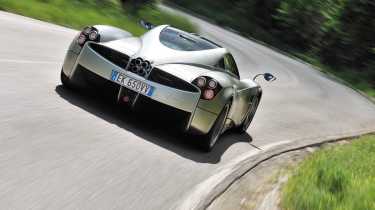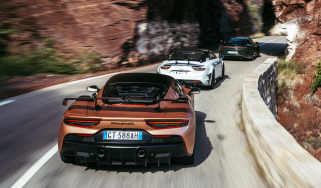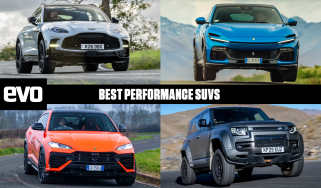Pagani Huayra review, video and pictures
The Pagani Huayra replaces the legendary Zonda. Does it also join the supercar hall of fame?
Goosebumps. That’s what separates the outrageously brilliant from the merely excellent. Drive a Porsche 911 GT3 RS and you’ll get them; a Ferrari 458 Italia serves them up before you even start the engine, a Renault Clio Cup yumping over the kerbs at the top of Eau Rouge makes you feel like you’re plugged into the electricity mains…
And the Pagani Zonda? Well, the first time I drove one there were goosebumps on goosebumps. That wailing AMG V12, the gorgeous feedback and effortlessness of the steering, the sheer tactility of the surroundings and the sense that inertia had ceased to exist as soon as I pulled that flyweight carbonfibre door shut. The Zonda compressed time, not just in the way it accelerated, but the time from input to output. You steered, it turned – instantly. You brushed the throttle and another 2000rpm appeared on the dial – instantly. You braked… well, you get the picture. The Zonda looked like a spaceship and seemed to dart joyously around as if powered by some sort of alien technology. It was, and remains, an extraordinary machine. From nowhere, we had a new supercar hero. That was 2001 and the Pagani Zonda has since stood toe-to-toe with Ferrari’s Enzo, Porsche’s Carrera GT and even the mighty Bugatti Veyron. It made the Ferrari feel cheap, the Porsche unnecessarily highly strung, and it outmanoeuvred the Veyron even if it couldn’t live with its bruising performance. Even now the Zonda is the benchmark supercar, its evolution leading from the 389bhp C12 to the remarkable 760RS that we also drove in 2012. Of course you know all of this: you know your F Roadster Clubsport from your Cinque, your R from your HH. But it’s worth the recap, for when you look at the incredible impact and staying power of the Zonda formula you start to understand the weight of expectation on the Huayra (say ‘Why‑ra’ and the boys in the factory will be happy, even if Horacio Pagani himself favours a guttural ‘Gwhy‑ra’). Imagine the magical qualities of all your favourite albums rolled into one cohesive whole. That was the Zonda, and the Huayra is the Difficult Second Album from hell. It looks good. I know, I know… you’re not sure about the slightly guppy face, right? It’s not my favourite view either, but in the raw the Huayra is jaw-dropping and just gets better the longer you stare at it. Those elegant teardrop wing mirrors, the head-swirling rims with spokes that get progressively more twisted, the lines that flow like honey from front to rear and finish in exquisitely bold shapes, the way the body seems stretched tight over its carbon-titanium chassis like an Adrian Newey F1 car. Before I landed in Bologna and took the short drive to Pagani’s temple to carbonfibre I was firmly of the opinion that the Huayra looked a bit awkward and that I preferred the Zonda, but within a day the new car just seemed so much more modern, and more exciting too. Trust me, you’ll love the Huayra soon and, of course, it could only be a Pagani. Allow Horacio to talk you through the detail of the Huayra (set aside two days for this) and you’ll want to adopt Greece’s financial strategy. What’s 845,000 euros plus local taxes – let’s call it £820,000 on the road – when Europe is already in for trillions? I’m sure the Germans will bail me out if I ask nicely. So you flick a delicate catch and the huge door hisses up, gullwing-style. The strut is only just strong enough to take the door on its journey and asks a bit of effort from you. I love that. Wouldn’t want a huge, musclebound strut – too heavy. The Huayra is 1350kg dry. In this left-hand-drive car you step into the footwell with your right foot, reach across your chest with your right hand to grab the loop of leather. Now sit down and pull the door down as you do so. You’re in. Inside a leather, carbonfibre and aluminium cocoon of obsession, every detail agonised over and beautifully thought out, every material used sympathetically and expertly integrated into this stunning sculpture. The driving position is superb. I won’t bore you with the details simply because there are too many to list – so many it’s almost overwhelming. Just look at the pictures and soak in the madness of it all. Some will surely find it all a bit too much, but even the most cynical will struggle not to smile and coo if they get a chance to sit inside a Huayra. It’s pure theatre. All this stuff was never in doubt. Horacio Pagani is an engineer and connoisseur, and the Huayra is a labour of love that’s been in the making since 2003. It was always going to be a mid-engined Faberge egg, fastidious and flamboyant. But there are bigger questions for people who read this magazine. Questions like can a 6-litre V12 with forced induction ever match the noise, throttle response and sheer drama of the old naturally aspirated 7.3-litre motor? Can Pagani’s young test driver, Davide Testi, recreate the supple, subtle brilliance that his legendary predecessor, Loris Bicocchi, poured into the Zonda like whipped cream? Can lightning strike twice? The Futa and Raticosa passes, stomping ground of Ferrari and Lamborghini test drivers since the dawn of the breed, are where we find out. Pull the aluminium, Huayra-shaped key apart like you might a car-shaped USB stick, slot it into the centre console below a row of slender oval switches and twist. The metal-faced dials light up in blue and the needles swing around their arcs before resetting at zero. Twist again and the starter whirs before the twin-turbocharged AMG V12 catches with a resounding Boom! The engine noise is deep and saw-toothed. Blip the throttle and it crackles like a racer. The early Zondas used to wrap you up in a warm, sonorous howl, the Huayra’s anger rather sets you on edge. It’s like you’re being tapped on the shoulder and reminded that this rear-wheel-drive supercar has 720bhp and 737lb ft of torque. Incredibly, AMG has more staff working solely on Huayra engines (67) than are actually employed at Pagani HQ. It’s taken a huge amount of time and effort, but Davide Testi suggests that the twin-turbo engine is now every bit as responsive as the masterful normally aspirated motor it replaces. Behind the V12 there’s an Xtrac seven-speed automated-manual gearbox. It’s a single-clutch set-up as Pagani couldn’t bear the thought of a heavy twin-clutch arrangement sat at the rear of the car. It weighs just 96kg and by Pagani’s reckoning a twin-clutch unit capable of handling 737lb ft would be closer to 200kg. Furthermore it’s mounted transversely to improve the weight distribution and create a safer, more manageable car at the limit. This was a key consideration right from the start of the project. Horacio admits that when the Enzo, Carrera GT and Veyron arrived in short succession he was concerned that his tiny company wouldn’t be able to compete. However, when he drove them he felt more confident. He’s a car nut (look in his lock-up and you’ll find a Gulf-liveried Ford GT nestled closely beside a lovely E-type Roadster) and loved each in its own way, but quickly identified the Carrera GT as the most impressive. ‘It is a beautiful car and an incredible piece of engineering,’ he beams. ‘However, it is not an easy car to drive. It is very challenging at the limit. We wanted something with a little more understeer and a more progressive balance.’ From an engineering point of view, the transverse single-clutch ’box is the optimum set-up, then. However, pulling back the intricate gear selector (67 parts aimed at creating a mechanical feel when in reality it simply connects a solenoid) and waiting to hear the distant thunk of first gear engaging, I can’t help wondering if Ferrari and Bugatti owners might find the ponderous low-speed rigmarole slightly absurd. Tickling the throttle gets the Huayra rolling but you do feel like you’re second-guessing when the clutch will fully release, so immediately a barrier is put between you and the car. Remember that ability to compress time? Well here it feels like you’re waiting for the Huayra to catch up. Pulling out of a junction across traffic can be a nerve-jangling affair. Fortunately that hesitancy is short-lived and, once above walking pace, the Huayra delivers rapid, decisive shifts. Within 100 yards you’ll have hit the ESC button (which resides on the steering wheel and alters not just the level of electronic stability control that its initials might suggest, but also throttle response and gearbox behaviour) to switch from Auto mode to Comfort so you can use the smooth, wheel-mounted paddles for total control. You’ll have noticed that familiar Zonda suppleness, too. When Horacio had been talking about understeer and useability I confess I was rather worried that the Huayra might feel a little too soft and cuddly, but actually it’s perfectly judged – comfortable but with an underlying control and firmness so you know you’re in something very serious indeed. However, pootling around below 3000rpm, gearbox snapping between ratios with a sweet pfffftttt, the Huayra feels refined and effortless. Better still, the throttle response – even driven gingerly and well below where you’d expect the turbochargers to be working – is superb. If somebody told you the Huayra was normally aspirated you’d be hard-pressed to dispute it. Unless, that is, you’ve cracked down the windows a couple of centimetres. Suddenly the deep industrial gargling is entirely subsumed by the swirl and huffs of the intake system and the chirps and chatter of the turbos. The sheer volume of air this engine requires suddenly feels almost tangible. It’s rather wonderful to feel the insistent forces it provides and simultaneously hear it sucking that performance from fresh air. But unlike that definitive turbocharged supercar, the Ferrari F40, there’s no off-boost lethargy nor a fairground spike of runaway power. In fact the delivery is genuinely progressive. Progressive but savage. My god it goes. The road up to the Futa is a string of villages with just a few hundred yards between them, but it’s enough to feel the engine surge up to 6500rpm in second. Quite how the rear 335/30 ZR20 P Zeros cope with the torque is beyond me, but they are absolutely hooked-up and the result is that your legs go light and your head is held and pressed hard against the seat. ‘Violent’ is the best word to sum up a trip from 1500 to 6500rpm in one gear. As the pass winds up into the trees and the villages dwindle in number and frequency, I get to enjoy the delivery for sustained periods and feel the carbon-ceramic brakes bite hard, the much-talked-about active aero wings lifting to increase drag and the suspension actively compensating before any destabilising dive sets in. What’s blindingly obvious is that the transverse-mounted ’box and the general commitment to keeping mass to a minimum has once again paid dividends. But the engine is just phenomenally powerful and when it’s delivering the full 737lb ft of torque, it scrambles your brain. This is the sort of performance that doesn’t dull even with prolonged exposure. Perhaps more impressive is that the chassis feels so able to soak it up. The traction is truly extraordinary and the light, compact drivetrain creates a supreme ability to change direction even when under full attack from the might of the V12. Such is the Huayra’s stability that very quickly you use Sport mode as the default setting. This reduces shift times to a scarcely believable 20 milliseconds, further improves throttle response and gives the traction and stability control systems a much better sense of humour. In fact it gives all the freedom you’d ever need on the road and on occasion those monster Pirellis fizz demonically over big crests, requiring nothing more than a gentle correction that feels like the most natural thing in the world. Futa blends into Raticosa and then, just by the handy Chalet Raticosa, the road splits. Dive left onto the SP58 and you’re on your own. The bikers all seem to stay on the main passes, so this little spit of road that runs along a high ridge and then eventually down to a near-deserted village is empty. We take a little breather at the Chalet for a sandwich and a hit of espresso. Test driver Davide joins the evo team of myself, Harry Metcalfe, photographer Dean Smith and the hideously attired video ace Sam Riley. Davide asks what I think… I haven’t really thought much at all. I’ve just tried to keep £820,000-worth of carbonfibre and titanium out of the undergrowth and done my best to keep up with that engine. So I give it some thought. I’ve already grown to love the snap of the shift, which isn’t brutal like an Aventador’s but feels just as quick and much more enjoyable. It really has the feel of a pneumatically actuated race ’box. Shame it’s a bit creaky at low speeds. I also love the fury of the engine and the spooky traction. I wish the steering was a little quicker and a fair bit lighter – why go to such lengths to create a lightweight car and hide its agility with a heavy rack? Davide admits he feels the same and prefers the most aggressive of the three steering racks that are offered (our test car has the middle option). I wish the ceramics had that instant bite that only Porsche seems to nail. The Huayra’s brakes are much closer in feel to a Ferrari’s, with a longer pedal travel and a coarse, grainy feel that suddenly goes heavy and dead as they get really hot. But above all I love the way the Huayra provides all the tools to use 720bhp pretty much at will. I’m relieved that nearly everything is either good or great. Mainly because Davide looks like he could rip my head off with one hand. I want to tell him that the way the Huayra’s stability liberates you to really work the chassis, engine and brakes to their maximum even on a narrow, unpredictable road reminds me very much of an Audi R8. However, maybe he wouldn’t like the comparison. I mentally note to save that observation for print, by which time there’ll be a good 800 miles between Davide and me. The comparison is valid though, and I couldn’t be happier that a rear-drive 720bhp Pagani can feel as secure but also as indulgent as the fabulously balanced R8. It breeds confidence and makes 720bhp exploitable. There’s just one thing missing so far. Those goosebumps. This is indisputably the road to go looking for them. And this is the moment I’ve been dreading and looking forward to in equal measure. Dean, absolutely deadpan, delivers the photographer’s most evil line: ‘Do you want to have a quick run up and down to see which corner works?’ Erm, I think he means for an oversteer shot. ‘You know this thing is worth nearly a million quid?’ I offer, helplessly. ‘Better make sure it’s the right corner then,’ says Dean. There’s very little that concentrates the mind like flicking a Huayra’s ESC button from Comfort to Sport, which makes the central display turn red, presumably for danger, and then bringing yourself to hold the button down for a few more seconds until the display reads ‘ESC Off’. Somewhere in an insurance company office in the UK an alarm sounds furiously and people whimper. Even Harry retreats into our Focus hire car and buries his thoughts in his iPhone with a rueful, ‘Oh heck.’ I tell myself it’s just a car and go corner-hunting. For the first mile or two I do what I always do when stability systems are disengaged: drive more slowly. Suddenly I’m on high alert, tense and clumsy. But soon the Huayra’s natural stability reassures my senses and pretty soon I’m driving above and beyond where I’ve been before. That settling understeer is still present, but drive hard into it and the front tyres push back; they’ve found their slip angle and they’re staying with it. Snap from one direction to another and the Huayra responds quickly, shrugging off inertia in the best Zonda tradition, and that mild understeer keeps the rear in line and driving hard. I dare to wonder if a 224mph car should feel so benign. A blind right, a few too many revs and the Huayra snaps sideways and I’m pointing at a steep grass verge for maybe a quarter of a second. When I open my eyes again I’m pointing straight, so I just pull another gear and give the V12 its head all over again. Phwoar. Scary. Deliciously, heart-thumpingly scary. That’s more like it. The Huayra might seem like a pussycat much of the time, but take any liberties with it and it’s still liable to bite you. Face flushed, heart BPM bouncing off the rev limiter, limbs heavy with adrenalin – not many cars can provide moments like these. It’s the payback for that immense traction: when the rear tyres finally cry enough, the V12 is right in the crazy part of its power curve and wheelspin builds in a wicked flare. It’s testament to the chassis’ inherent balance that this doesn’t immediately spin the Huayra around. In fact although respect is most definitely due, the Huayra remains tactile and composed even beyond the limit. You won’t ever want to pull wild oversteer slides on a narrow mountain pass but you can tweak and tease the car. And when you start to provoke this monstrously fast car on corner exits and spin the rear tyres up just as the road straightens, you know that Davide has created something of a masterpiece. You wouldn’t – couldn’t – drive a Carrera GT like this. Dean gets his shot, Harry is relieved, alarm bells stop ringing in Northants and Davide looks happy. Phew, can we go home now? We can but we don’t. We’re an hour or so from the airport and this is Italy, so we assume arriving about ten minutes before the plane is due to depart will be plenty. That leaves us another hour or so to get under the skin of this extraordinary car. Some owners will only ever feel its incredible stability, the ease with which it lets the driver experience massive performance with a relaxing effortlessness. However, the Huayra is more than a Zonda refined and sanitised. It’s a car with its own personality – or rather its own split personality. Beyond the refinement and ease of use is a demon with one eye open waiting for its turn, a car that is scintillatingly fast and hugely demanding, a car that can thrill and terrify in equal measure, a supercar in every sense of the word. The gearbox isn’t perfect, a little of the Zonda’s steering feel has been lost and some people will suggest that a twin-turbocharged engine will never hold the romance nor offer the response of a huge, normally aspirated V12. They might even have a point. But when that engine is hurling you into the sunset, hitting you again and again with all its might, you won’t care a damn. You might even be too wired to notice those goosebumps, but they’re present and correct. I’ve still got them now.
See the Huayra in action below...
Driving it in the UK, the Pagani is intimidatingly big as you crawl through town. Released onto damp A- and B-roads, you try to use the lag, keep the revs below 3500rpm, short-shift with those light-action paddles, yet there’s still phenomenal force being squeezed from the AMG engine in great chunks and the odd slide is inevitable. It’s indicative of just how well-sorted the Huayra is that it’s controllable rather than instantly hedge-hunting in such situations, but there’s a feeling that you’re trying to slice a lemon with a chainsaw
With warmish tarmac, it’s a very different story. Deploying everything the Pagani has down a straight is as utterly intoxicating as gazing at its interior. The hypercar free-fall G-forces are all present and correct, but it’s also the fact that the engine behind you seems to be a living, breathing thing with more chuffs and whistles than a drawing room full of snoozing grandfathers. It’s a fascinating soundtrack, as if a whole new type of powerplant has been used for propulsion, but without any real crescendo to the sound (it’s very quiet from the outside, too) it’s also quite hard to judge the revs – and the beautiful dials certainly won’t help you decipher anything!
The ride is firmer than you might expect: not as creamy as a Pagani Zonda, but you can push hard into corners, really leaning on the front end. Although you’re always aware of the large amount of car behind you, the traction from those huge 20in rear tyres gives you real confidence. The idea of hustling an unpronounceable Italian supercar over stone bridges and down roads that are essentially no more than a metalled drover’s track might seem as absurd as riding a camel in the Kelso point-to-point, but the Pagani proves it’s possible. Quite some achievement. And enough to see the Huayra share evo's Car of the Year 2012 crown with the Lotus Exige S V6...




